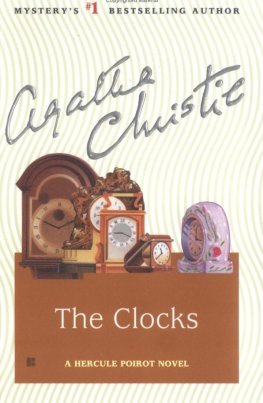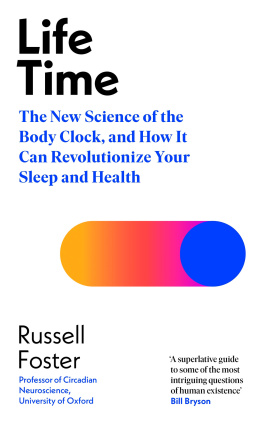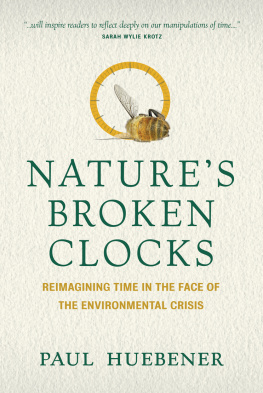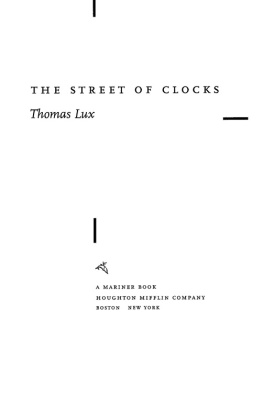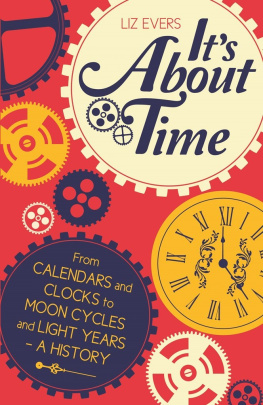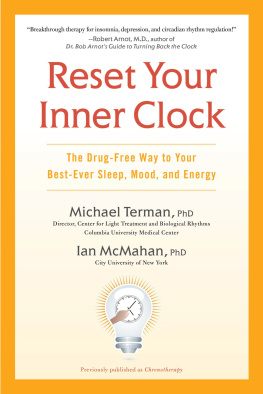Internal Time
Internal Time
Chronotypes, Social Jet Lag, and Why Youre So Tired
Till Roenneberg
Harvard University Press Cambridge, Massachusetts London, England 2012
For Casper, Pauline, and Flora
Contents
This book is about clocks. Not about those you can buy, wear, or hang on a wall, but about the clock that ticks away in your body. The body clock is not a new invention in the long line of evolution. You share your ability to internally keep track of the time of day with practically every other creature on earth, from other mammals right down to those organisms that exist only as a single cell. This means that an internal biological clock must be extremely important for life on this planet. Living without or against the biological clock would mean premature death by predation or starvation for most animals in their natural environment. As I will elaborate in this book, living against our biological clock also jeopardizes our health and well-being. In modern society, we rarely live in synchrony with our body clock. Some of us travel fast across many time zones, and others (about 20 percent of the working population in industrialized societies) have to work in shifts. If you have ever suffered from jet lag, you know how strongly we are affected when our body clock is out of synch with social time. But even if you dont work in shifts and never travel across time zones by airplane, you can still suffer from a chronic type of jet lag, which we call social jet lag.
A book about clocks is evidently also about time, yet the time of the body clock is not necessarily the same as the social time that we use in everyday life to be on time for work, travel, appointments, or the evening news. Social time is the time people live by. In the nineteenth century, social time was local sun time: noon was when the sun had reached its highest point. This rather sensible long-standing convention about time was eventually challenged by trains: they could transport humans over long distances within a few hours, rendering local sun time impractical because passengers had to reset their clocks at almost every station. States and countries, therefore, adopted a universal system in 1884, subdividing the world into twenty-four time zones that all refer to a zero line, the longitudinal meridian that crosses the observatory in Greenwich, near London. Theoretically, social time could adopt any time frame, as long as everyone used the same one. The entire territory of mainland China, for example, is covered by a single time zone based on Beijing time. This book will tell you how these different time systems interact: sun time, social time, and your very individual internal time.
Your internal time is produced by your own body clock. It varies from individual to individual just as body height, eye color, or personality varies, and it interacts with sun time and social time. In spite of internal time being probably the most important to our health and well-beingmore important than sun time and certainly more important than social timeit has been thoroughly neglected. Every day, we are awake for approximately sixteen hours until we render the control of our movements, thoughts, and desires to a state resembling unconsciousness, which we call sleep. These daily changes are so utterly obvious that the underlying biological mechanism remained unexplored for centuries. In synchrony with the rise and fall of the sun, animals awaken and sleep, plants open and close their blossoms, and plankton travel up and down the water column. All these rhythms are controlled by a biological clock that represents the twenty-four-hour day of our planet. The alterations between sleep and wake are not simply two states of our existence that are being flipped like a coin once a day. They are reflections of a continuous change in all our bodily functions; a change that involves both turning genes on and off and continuously changing the cocktail of hormones and transmitters in all our tissues.
I have been studying the biological mechanism underlying our body clock for decades in very different creatures ranging from single cells and simple fungi to humans. These studies were conducted either in the laboratory, where we try to control all environmental factors (such as light, temperature, and food), or in the real worldfor example, in factories, where we measure different variables over the course of the day, or in the world at large, by simply asking normal people when they do what. My initial reason for studying the body clock was autobiographical and almost by chance. One of the pioneers of the field, Jrgen Aschoff, was the director of a research institute in the Bavarian countryside. Jrgen and his wife, Hilde, had six children, who attended the same school that I did. I became friends with all of them, despite age differences. The Aschoff family lived in a beautiful castle (the Schloss) on the slope of a hill in Andechs, a village near the Ammersee, one of the larger Bavarian lakes. Andechs was a long way out in the countryside with almost no commuting possibilities. The Aschoff parents, therefore, allowed their children to invite friends to stay whenever they wanted, even overnight. To be part of a large crowd of youngsters who were all extremely interesting and interested was a lot of fun, and I stayed at the Schloss as often as I could. I also got on extremely well with the professor himself and became more and more interested in the science that he and his colleagues pursued.
When I was about seventeen, I began to work as a part-time assistant at Aschoffs institute during most of my school holidays. It allowed me to combine the fun of learning science, spending time with fascinating people, and earning some moneya dream situation. There were always many visitors: friends of the parents; friends of the children; but also lots of scientists, some of them internationally famous, who seemed to be engaged in endless scientific discussions. I had always loved science, but the atmosphere in Andechs gradually turned me into a junkiethis was exactly the life I wanted to lead.
Although I probably had assimilated more knowledge about body clocks by the time I entered university than most students do by the time they graduate, I started to study physics, in my view the most fundamental science of all. But I soon realized that the true aim of my interests concerned humans and that physics just didnt get me any closer to understanding them. So I switched to medicine. But once again, I felt that this discipline would not be the right vehicle for my curiosity. Although I wanted to know everything about humans, the focus of my interests wasnt on helping or curing them. I began to appreciate that I could only start to learn something about humans if I understood more about evolution, genetics, biochemistry, comparative physiology, and ecology, but none of these subjects was taught in any depth in medical school.
I finally ended up studying biology. I enjoyed discussions with other students and scientists much more than attending lectures, and I read lots of papers and books that covered many more issues than those taught in a degree program. I felt that my learning only began when I started working in the lab, collecting experimental data and then trying to make sense of them. The attempts at making sense of data always were my utmost joy in scienceand still are. I think that this joy, and the ways and methods I use to approach the mysterious world of data, go back to my intensive interactions with Jrgen Aschoff when I was at a very impressionable age.
After a detour into photobiology, neurophysiology, and brain research that lasted for many years, I finally returned to the field that investigates biological clocks (chronobiology) as a postdoctoral fellow. I spent my first postdoc time back in Andechs, working with Jrgen Aschoffnot as a student but as a (somewhat) fledged scientist. I remained a colleague and friend of the old one, as his family and his close friends called him (although he never ceased to be my mentor), until he died in October 1998. After two years studying annual rhythms in humans with Aschoff, I was eager to learn more about how biological clocks work in cells, how they generate an internal day with the help of molecules. So I decided to work with another pioneer of chronobiology, Woody Hastings, a Harvard professor. I was part of his team in Cambridge, Massachusetts, for almost four years and kept going back during the summer for many more years. Returning to Germany, I found a rocky academic landscape for someone who simultaneously studied humans and single-cell algae, someone who was more interested in the investigation of concepts, such as the biological clock, than in staying within the boundaries of the little boxes created by our disciplines and faculties. Where did I belong according to orderly German academic criteriabotany, zoology, ecology, anthropology, or medicine? I ended up in the medical faculty, specifically in the department of medical psychology. Ernst Pppel, the chair of the department, provided this scientific home, where I still reside. He was one of the few also interested in concepts (especially those regarding time), and less focused on the specific model organisms that were used to study them.
Next page

